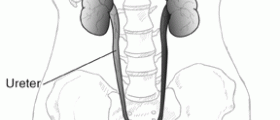
Kidney dialysis is a procedure that represents an artificial replacement for lost kidney function. The procedure is performed in people suffering from an acute disturbance in kidney function (temporary treatment) and patients with severe and permanent damage to the kidneys (chronic renal failure). There are two types of dialysis, hemodialysis and peritoneal dialysis.
Hemodialysis
Hemodyalisis requires a machine called a hemodialyzer. This machine works as an artificial kidney. Patient's blood is filtered in the machine and cleaned from all the waste and toxic substances that are normally excreted by the kidneys. The blood then returns to a patient's body.
Hemodialysis requires an arteriovenous fistula. An arteriovenous fistula is surgically made. It represents a communication (abnormal passage) between an artery and a vein and is commonly made on the arm. In case it is not possible to create an arteriovenous fistula the dialysis is performed via a tube that joints an artery with a vein or in case this is not possible filtration of the blood is performed through a narrow plastic tube that is inserted in the neck vein.
Once the patient is connected to the dialysis machine the blood leaves the patient's body via one needle and enters the machine. It is then cleaned and it reenters the patient's body via the second needle. The very process of hemodialysis lasts approximately 3-6 hours. After the treatment the needles are removed and patient goes home. The process must be repeated after a few days. Hemodialysis is repeated three times a week.
Peritoneal Dialysis
Peritoneal dialysis is another form of artificial elimination of all the waste products and toxic substances from the body. In patients who undergo peritoneal dialysis a surgeon places a plastic catheter into the abdomen (abdominal cavity). This catheter serves as a passage for dialysate, a fluid that assists in cleansing the blood from waste products. This fluid draws waste products from the blood. The peritoneal cavity acts as a membrane that filtrates the blood and once the waste products are eliminated in the dialysate the fluid is drained from the abdominal cavity. The procedure lasts approximately 4-6 hours per day and draining of the dialysate takes about 30-40 minutes.
Even though patients suffering from terminal renal failure cannot live without dialysis this is a very exhausting procedure. The most common side effects of dialysis are low blood pressure, fainting and fatigue. Patients are due to pay attention on what they eat and on how much fluid they take on a daily bases. Intake of foods that contain sodium and potassium must be limited. And finally, these patients undergo regular check-ups.
















Your thoughts on this
Loading...